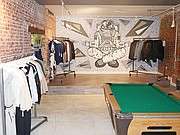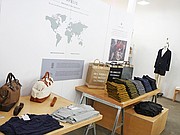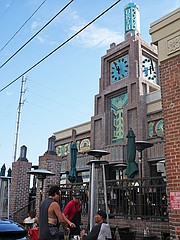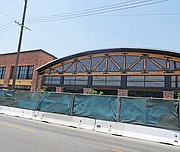ARTS DISTRICT
Arts District; L.A.’s Next Big Retail Area?
Every major city has an “anti-downtown,” said Sam Brownell, principal and partner of property developers Blatteis & Schnur Inc.
Examples include the SoHo/Meatpacking District in New York City, Wynwood in Miami and the Fulton River District in Chicago. “It attracts the creative class, where music, digital content, film businesses go,” Brownell said of the model for the anti-downtown.
After an unprecedented construction boom in downtown Los Angeles, the city’s downtown area is quickly developing its own “anti-downtown,” Brownell said. It is going to be the Arts District, a formerly blighted area sandwiched in between the Little Tokyo neighborhood and Boyle Heights in East LA.
Blatteis & Schnur is wrapping up construction of At Mateo, a 190,000-square-foot development in the Arts District. Brownell and Blatteis partner Marc Guth are betting that affluent creatives will want to open offices at At Mateo, as will boutiques and restaurants, which will feature 100-year-old brickwork that will blend in with the still-gritty environs of the Arts District.
High-end retailers also have been taking a risk on the Arts District. Dover Street Market, the avant-garde retailer from Comme Des Garçons’ Rei Kawakubo, confirmed that it is scheduled to open a store in the Arts District in 2018.
Leading streetwear retailer Bodega is scheduled in September to move into the Row DTLA creative office, retail and dining compound, which is a two-minute drive from the Arts District. In the 1970s and 1980s, the district was known as a place where musicians, performance artists and visual artists maintained sprawling work/live lofts.
The Arts District was also the location for a recent pop-up shop produced by the collaboration line Louis Vutton X Supreme. It ran June 30 to July 7 on the corner of East Third and Garey streets.
In May, the Phillip Lim 3.1 brand opened a boutique on the main drag of the Arts District on East Third Street, between East Fourth Place and South Vignes Street. Lim’s flagship in West Hollywood closed late last year. In late 2016, the Shinola brand opened a boutique in the area. Rogue Collective, a Los Angeles brand, opened a shop on the former site of a punk-rock club called Al’s Bar around the same time. A few months before Rogue’s debut, high-end camping lifestyle store Hatchet Supply Co. opened in the district.
Upscale retail started in the enclave around 2011–2012 with the opening of Apolis on East Third Street and Guerilla Atelier.
Guerilla Atelier operated a couple of different addresses in the district before it found its home in a sprawling space across the street from Hauser & Wirth, a 10,000-square-foot art gallery. Hauser & Wirth opened in December 2016 and has attracted international tourists as well as visitors from all over Los Angeles County. Another attraction, the Museum of Ice Cream, took a bow in April.
Popular restaurants have also opened in the Arts District in the past six years. Soho Warehouse, a project from Soho House, a popular international club with celebrities and the affluent, is scheduled to take a bow in 2018. Warner Music Group also is scheduled to open a big office at the Ford Motor Factory compound, the site of a former Model T plant. It is slated to be transformed into creative offices.
More housing units are scheduled to be built in the area. Camden Property Trust is scheduled to build 344 live/work units in the Arts District. In 2015, the One Santa Fe development opened with 438 residential units and high-end retail, such as the Wittmore boutique.
There’s a lot of momentum in the Arts District, but there’s another reason David Fishbein of Runyon Group, consultants for Row DTLA, are bullish about the Arts District. It’s a walkable place like Abbot Kinney. Over the last decade, the once-blighted area on Los Angeles’ Westside evolved to become a popular retail enclave, earning the title “the coolest block in America” in 2012 from GQ magazine.
“There are structures with great integrity [in the Arts District],” Fishbein said. “You got one- to four-story buildings rather than 20-story buildings. You have infrastructure that can create walkable street grids. It’s what Los Angeles people are craving. That’s why Abbot Kinney was popular.”
Even with this momentum, the jury is still out on retail in the Arts District. Jay Luchs, a prominent player in Los Angeles’ real-estate game, said he often includes the Arts District on tours of top retail streets in LA but retail executives rarely request it.
“I think it is important that my own clients see it,” Luchs said. “The word on the street is that restaurants do so well there and people want to be near that. But there is nothing to say that retail is there yet,” said Luchs, the vice chairman of NewmarkGrubbKnightFrank.
Luchs said a square foot of retail space costs $5 per month around the main drag of the Arts District.
Brigham Yen, a real-estate broker and publisher of the “DTLA Rising” blog, said the area has a way to go. “I think the Arts District is ‘arriving.’ It’s definitely on people’s radar, but it doesn’t have enough concentration of shops yet to make it into a full-on shopping destination. That’ll change within the next several years, I believe. It’ll be critical to make the roads more pedestrian friendly as well as to incentivize people to explore the Arts District on foot,” he said.
In April, the state of California awarded the city of Los Angeles more than $14 million in grants to improve foot and bike areas in the Arts District.
The transition from blighted area and artist zone to a district of offices and shops is not resulting in a mass exit of artists so far, said Johnny White, a photographer, filmmaker and art director who has been living in the district since 2004.
“There are still artists in the Arts District. Look at all of the empty spaces here,” he said of extra real estate in the area. “There are a lot of non-artists moving into the neighborhood, but there are no fewer artists.”
Other fashion businesses beside retail are taking interest in the Arts District. Japan’s Edwin Jeans opened a North American headquarters in the Arts District in April. Vince Gonzales of Edwin said that people would have called him crazy up until a year ago. “Now they all say, ‘Cool! What a cool space,’” Gonzales said.



























